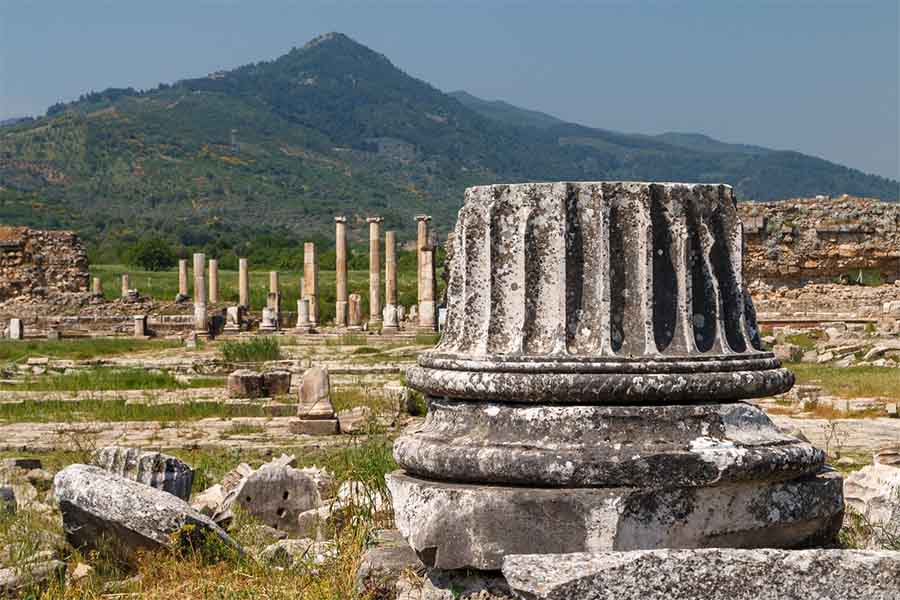Temple of Zeus Gate Rises In Turkey’s Magnesia on the Maeander
Archaeologists in Turkey have excavated the entrance gate the Temple of Zeus at Magnesia. The site of Magnesia on the Maeander is relatively unknown in the annals of Aegean Region archaeological sites in Turkey, but ongoing excavations are making it an emerging destination for history fans.
The Zeus Temple was located in the city of Magnesia on the Maeander, in the Ortaklar district in Turkey's southern Aydin province, about 19 kilometers from Ephesus and 24 kilometers from Miletus. The latest discoveries have been made at the Zeus Temple on the slope of Mount Thorax.
The first excavations at the archaeological site were performed during 1891 and 1893 by a German archaeological team. The theater, the Artemis temple, the agora, the Zeus temple and the prytaneion were all discovered at this time. In 1984 Orhan Bingöl of the University of Ankara and the Turkish Ministry of Culture excavated further buildings and determined that many of the architectural features and statues at the Zeus Temple site were destroyed by local lime miners.
Gate of #Zeus Temple discovered in western #Turkeyhttps://t.co/9f7ZBkHPsY pic.twitter.com/lRNH0KbLeJ
— Hürriyet Daily News (@HDNER) September 28, 2021
- The Unshakeable Power of Zeus, Prime Mover of Ancient Greek Deities
- Five Female Olympians of Ancient Greece: The Good, the Bad and the Ugly
Unearthing The Sacred Sites of Magnesia
In July 2018, six Greek statues were discovered at the temple site and now Anadolu Agency (AA) have announced that “the Zeus temple gate and a further 80 statues and various artifacts” have been unearthed. Professor Görkem Kökdemir from Ankara University’s Archeology Department, who led the excavations, told Smithsonian Mag that Magnesia was a prominent city in ancient times and that religious festivals were held in temples and sanctuaries. In ancient cities people [worshipped] “not just one deity, they [worshipped] multiple gods or goddesses,” added the professor. Therefore, the Zeus Temple, in the sacred agora, “is very significant. It is the second important cult [of Magnesia],” said the archaeologist.

The first cult followed is Artemis. Here the Temple of Artemis in Magnesia on the Maeander, Turkey. (nejdetduzen / Adobe Stock)
A report on Turkish Archaeology News explains that according to Greek tradition, Magnesia on the Maeander was founded by the colonists from the tribe of Magnetes who arrived in Asia Minor from Thessaly. The city was founded on the banks of the small river Lethacus, a tributary of the Maeander: a strategic commercial location in the triangle of Priene, Ephesus and Tralles. The surrounding territory was “extremely fertile, producing excellent wine, figs, and cucumbers,” according to Strabo. The legendary historian also describes the location of Magnesia as “The first city one comes to after Ephesus is Magnesia, which is an Aeolian city and is called Magnesia on the Maeander, for it is situated near that river.”
- Athenian Agora, Where Some of the World’s Greatest Philosophers Gathered
- Myrmidons: The Fiercely Loyal and Unstoppable ‘Antmen’ Army of Achilles

The magnificent stadium at Magnesia. (CC BY-SA 4.0)
Resurrecting Ancient Pilgrimage Sites For Modern Tourists
In the 19th-century, digs Humann unearthed a small portion of the Temple of Zeus which are currently housed at the Pergamon Museum in Berlin. Now, Greek Reporter says Kökdemir expects his team to uncover “60 to 70 percent of the original temple structure that once boasted pillars of around 16 feet tall that supported a 24 feet high roof.” An article in Jerusalem Post explains that the Temple of Magnesia Zeus is well-known in the history of architecture and Görkem told the Turkish daily, Hürriyet Daily News, that the newly discovered Zeus gate, the replica of which is on display at the Pergamon Museum in Berlin, is part of “a well-known temple in the history of architecture,” just like the Temple of Artemis in the sacred district of Artemis Leucophryene.
The Temple of Artemis site comprises an altar to Artemis, a sacred spring, three porticos on the sides of the districts, and a processional area. While only the foundations of this temple have been preserved it was originally modelled after the grand Altar of Zeus in Pergamon. To the west of the temple is an area that was reserved for animal sacrifices to the goddess. With what is known about this temple, and what is now being learned about the Temple of Zeus, it will further enhance Magnesia on the Maeander as the historical tourists 2022 must see.
Top image: The temple of Zeus has been found amongst the ruins of the ancient city Magnesia (Magnesia on the Maeander), Turkey Source: lic0001 / Adobe Stock
By Ashley Cowie




















Comments
Hi All,
Just have a few questions about the site in general is there any evidence that this Temple could possibly be older? An if it is was zeus added or was it already there?
Why, I'm asking?
Because this temple was uncovered in Turkey which was once upon a Time in Ancient History Mesopotamia. An in Mesopotamia that region worshipped another deity Marmaduke.
Although the figure was often depicted with Wing's an carrying two strange weapons in either hand shaped like mini-Tridents.
Once the Greeks arrived in Mesopotamia they simply renovated the Temple by changing the place of worship from Marmaduke to a temple dedicated to zeus. Are marmaduke an zeus both weather deities?
This is all, I can say about or rather ask of the temple to zeus in Tyre (Turkey). Until next discussion Everyone, Goodbye!